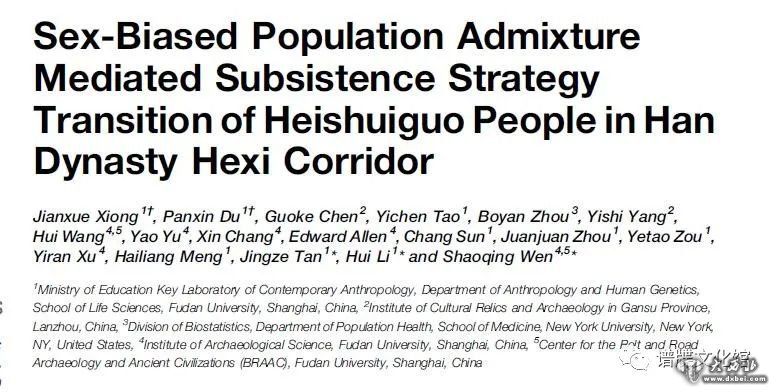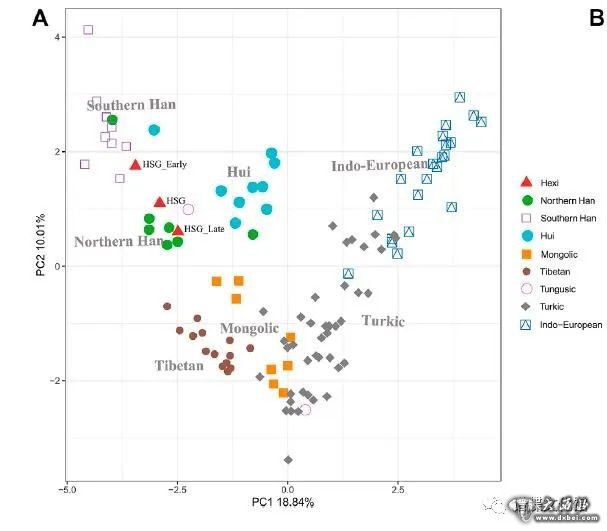2022年3月10日,復(fù)旦大學(xué)團(tuán)隊(duì)《frontier in genetics》(《基因研究前沿》)發(fā)布了《Sex-Biased Population Admixture Mediated Subsistence Strategy Transition of Heishuiguo People in Han Dynasty Hexi Corridor》譯《漢王朝河西走廊地區(qū)黑水國遺址人群的性別偏離的人口融合和生存策略的變更》,里面有31個(gè)中國古代DNA數(shù)據(jù),時(shí)間涵蓋公元前118-公元191年,非常驚人的事實(shí)顯示,這些古人的父系都是來自黃河流域的,母系則是當(dāng)?shù)赝林?,其中,父系類型與現(xiàn)代華北漢族人完全一致。

一、黑水國遺址和他們的生產(chǎn)方式
黑水國遺址,位置在甘肅省張掖市甘州區(qū),是古代西河走廊重地,這里被認(rèn)為最早時(shí)是古代月氏的國都。但需要指出的是,本文中的黑水國墓地樣本,全部來自公元前118-公元191年,此時(shí)已經(jīng)是霍去病攻占河西走廊之后了(公元前121)。(此時(shí),這里已經(jīng)不是月氏的國都,從新疆東部的一些間接數(shù)據(jù)可以推測,古代月氏人的父系是以R1a和Q1b為主的)。本文的DNA樣本,實(shí)際均是來自戍邊的古代漢族移民。

河西走廊一帶曾經(jīng)過多次農(nóng)牧變更:
早期的馬家窯文化(距今5800-4800年)、齊家文化(距今4200-3900年),均是以農(nóng)業(yè)為主的;后期的四壩文化(距今3800-3300年)、天山北麓文化(3500-3000年),則是農(nóng)牧結(jié)合的;在西漢中期以前,當(dāng)?shù)氐纳尘幕ň嘟?900年-2100年)和山馬文化(距今2700-2100年),是以飼養(yǎng)綿羊、山羊、馬、駱駝為主的游牧文化(月氏人是游牧的);而西漢中期以后,當(dāng)?shù)氐霓r(nóng)業(yè)迅速發(fā)展,豬和雞成為最主要的家養(yǎng)動(dòng)物。這一人口和生產(chǎn)方式的劇烈變化,可能與西漢王朝奪取河西走廊后的漢族移民有關(guān)。
對于早期的沙井文化,before the Han Dynasty, a claim supported by excavated relics and faunal remains from Shajing culture (2,900–2,100 cal yr BP) and Shanma culture (2,700–2,100 cal yr BP) sites. The importance of domesticated pig declined precipitously during this same period , while sheep/goat, cattle, horse, and camel emerged as the major domesticated animals along the Hexi Corridor。(譯:漢代之前,這一主張得到了出土文物和動(dòng)物群的支持,沙井文化(距今2900-2100年)和山馬文化(距今2700-2100 年)的遺址,家養(yǎng)豬的重要性下降了,同一時(shí)期,綿羊/山羊、牛、馬和駱駝成為主要的家養(yǎng)動(dòng)物。)
漢代后,當(dāng)?shù)爻蔀檗r(nóng)業(yè)區(qū)域,During and after the Han Dynasty (202BCE–220 CE), however, agriculture developed rapidly to become the subsistence strategy in this region.(漢代和漢代后,無論如何,農(nóng)業(yè)飛速發(fā)展,并成為當(dāng)?shù)爻掷m(xù)的謀生策略)
黑水國遺址中,農(nóng)業(yè)成為壓倒性優(yōu)勢的生產(chǎn)方式。This strongly suggested that an advanced agricultural technology became widespread in the Hexi Corridor during this period of time.Remains of chicken, pigs, dogs, sheep/goat, cattle, and horse identified at the Heishuiguo Han Dynasty tombs should be placed in this context. Chicken would emerge as the most commondomestic animal in this period, followed by pig(譯:這有力地表明,在這一時(shí)期,一種先進(jìn)的農(nóng)業(yè)技術(shù)在河西走廊得以擴(kuò)散。雞、豬、狗、羊、牛和馬的遺骸,在黑水國漢代墓葬被發(fā)現(xiàn),正是這種背景。雞成為了這一時(shí)期最常見的家畜,其次是豬。)
二、本文的31個(gè)古人樣本
文章共計(jì)提取了31個(gè)古代人樣本,測試了Y染色體和線粒體DNA。遺址的數(shù)據(jù)可以分為
Based on 14C dating, tomb morphology and grave good assemblages (Li, 2021), burials at Heishuiguo have been divided into four phases: Phase 1, during the middle Western Han Dynasty (118–49 BCE); Phase 2, during the late Western Han Dynasty (48 BCE–6CE); Phase 3, from the Wangmang Xin Dynasty through the early Eastern Han Dynasty (7–67 CE); and Phase 4, from the middle to the late Eastern Han Dynasty (67–191 CE)。(譯:基于碳14測年、墓葬形制、陪葬品組合,黑水國墓地可以劃分為四個(gè)階段:1、西漢王朝中期公元前118-公元前49年;2、西漢王朝晚期公元前48-公元6年前;3、王莽新朝和東漢王朝早期公元7年-公元67年;4、東漢王朝晚期67-191CE)
本文樣本的年代,early han大致相當(dāng)于公元前118年-公元6年,late han大致相當(dāng)于公元7-191年。
這31個(gè)古人的Y和mtDNA數(shù)據(jù)如下:

三、父系成分
父系上看,O2是最大的類型,其中O2-002611應(yīng)該是最大的類型,這一類型在漢族的偏東地區(qū)更加高頻,黑水國墓地中占據(jù)26.7%的比例。這些漢代的戍邊移民,其他父系Y類型也與現(xiàn)代漢族幾乎完全一致。
Haplogroups Oγ-IMSJST002611(26.7%), Oα-M117 (13.3%), and Oβ-F46(3.3%)represent three major founder paternal lineages and encompass more than 40% of the present-day Han Chinese (estimated 16% for Oα, 11% for Oβ,and 14% for Oγ)。These three lineages have been onsidered to be derived from Neolithic farmers in Yellow River Basin (Yan et al., 2014). The three haplogroups are also the most frequent among the Heishuiguo population, representing 43.3% of the total, similar to modern Han populations.(黑水河墓地的單倍型群Oγ-IMSJST002611(26.7%),Oα-M117(13.3%),Oβ-F46(3.3%)代表了三個(gè)主要的父系成分,占現(xiàn)代漢族人口的40%以上(其中Oα約占16%,Oβ約占11%,Oγ約占14%)。這三個(gè)血統(tǒng)被研究認(rèn)為來自黃河流域的新石器時(shí)代的農(nóng)民。這三個(gè)單倍型也是黑水國墓地中最常見的,占總數(shù)的43.3%,與現(xiàn)代漢族群體相似。)
從父系情況看,這些古代樣本,父系基本都是漢族移民的,沒有明顯的其他民族成分。也從另一個(gè)方面看出,漢代中原人群的父系,和現(xiàn)代漢族是高度一致的,沒有發(fā)生明顯變化。

By way of interpopulation comparisons (PCA and Fst heatmap) with reference populations (e.g., Southern Han,Northern Han, Hui, Mongolic, and Tibetan), we have been able to show closer paternal genetic affinity with Northern Han and Hui populations among the groups at Heishuiguo.(譯:通過比較(PCA和Fst熱圖)與參考種群(例如,南方漢族,北方漢族、回族、蒙古族和藏族)的對比,我們可以看出,黑水國墓地人群,與北方漢族和hui顯示出更緊密的父系遺傳親緣關(guān)系。)

來自現(xiàn)代膠東地區(qū)典型的O1b-F1759占了10%,長三角的O1a-F1736占3.3%,華南地區(qū)的O1b-F2924占3.3%,,說明這一區(qū)域的移民,不限于中原地區(qū),還有華南和山東地區(qū)。
三、母系情況
黑水國母系,出現(xiàn)了一定的中原地區(qū)罕見類型,與現(xiàn)代蒙古語人群接近,也和西北漢族接近,和華東漢族不一樣。
On the maternal side, the three Heishuiguo populations are tightly congregated, mirroring genetic continuity from the Early Han to Late Han. Meanwhile, the Heishuiguo population maps out close to Mongolian-speaking (e.g.Buryat) and Northwestern Han (e.g., Ningxia Han) populations, which indicates an indigenous maternal origin.(在母系方面,三個(gè)黑水國墓地人群緊密相連聚集,反映了漢初至漢末母系人口是連續(xù)的。與此同時(shí),黑水國的位置接近講蒙古語(例如布里亞特)和西北漢族人口,這表明母系的起源,是土著人口)

四、男性移民和歷史記載是相符的
史記記載了西漢王朝將中原移民遷移至此,而當(dāng)?shù)爻鐾恋腂amboo Slips (簡牘)則記載,移民來自以下具體的21個(gè)郡:these male immigrants in 21 counties from the Middle and Lower Yellow River (Hongnong 弘農(nóng)郡, He’nei 河內(nèi)郡, Langya瑯邪郡, Changyi 昌邑國,Pinggan State平干國, Dahe 大河郡, Chenliu 陳留郡, Runan汝南郡, Julu 巨鹿郡, Yingchuan 潁川郡, Shangdang 上黨郡,Henan河南郡, Jiyin濟(jì)陰郡, Nanyang南陽郡, Hedong河?xùn)|郡,Zhao State趙國, Dong 東郡, Liang State梁國, Zhangye張掖郡,Huaiyang淮陽郡, and Wei魏郡)
文章分析認(rèn)為,古代西漢的移民,主要是男性,造成了黑水國墓地遺址的古人DNA,出現(xiàn)了黃河中下游父系+當(dāng)?shù)啬赶档奶厥饨Y(jié)構(gòu)。
This is in accordance with historical records , where major migration events were often male-dominated migratory and frequently involved migration for garrison building, political migration, and migration of minority groups. Young males were usually the ones building garrisons, and most couldn’t bring their families outside of small local garrisons(譯:這與歷史記載是相符的,重大移民事件通常以男性為主,經(jīng)常參與遷徙的是駐軍移民、政治移民和少量移民。通常是由年輕男性建筑工事,他們中的大多數(shù)人不能把家人帶到當(dāng)?shù)兀?br />
(譜牒文化館 )
(責(zé)任編輯:張?jiān)莆?
(譜牒文化館 )










